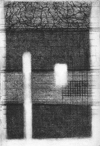statement
Perception, broadly defined, is the construction of a representation of the external world, for purposes of thinking about it and acting in it. Representation, as it manifests both perceptually and physically, can reveal and highlight unique knowledge about our experience. The beauty of our perceptual and physically representations is that they provide new insights into our everyday experiences because our perceptual representations are not always veridical.
The human perceptual system (in our brain) has to make sense of a great deal of information in the world. This is highlighted by the problem of perception. That is, the physical world is three dimensional with constant properties but is projected as a two dimensional image on the eye’s retina with varying properties. Yet our perception is three dimensional with constant properties.
How does the brain make sense of the two dimensional image?
The brain has to rely on some general “rules” (i.e., bottom-up processing) but is also influenced by our personal experiences and knowledge (i.e., top-down processing). Our perception can therefore be manipulated at the level of bottom-up processing (e.g., what we see in the physical world) or top-down processing (e.g., what we bring in terms of our individual experiences). Most of the time, bottom-up processing results in a perception of the world that seamlessly matches the physical world in that we do notice a difference between the perceptual and the physical. But occasionally there will be a disconnect as evidenced by the existence of visual illusions.
One theory about how we may organize the world perceptually was proposed by the Gestalt psychologists – “The whole is different from the sum of its parts”. The Gestalt psychologists also suggested principles of object grouping. In my art, these principles have been manipulated to create a tension between viewing the whole and its parts. Viewing from straight on, the parts are highlighted. But when viewed from an angle, the whole image comes into perceptual focus. This is also called an anamorphic image, meaning that it is meant to be viewed from a specific vantage point.
Currently, I am experimenting with artwork that further challenges each viewer’s perception using both psychological concepts I have previously employed in my artwork and other concepts based on how our perceptual systems function. I draw from my background as an artist and architect and my expertise as a perceptual and cognitive psychologist.
